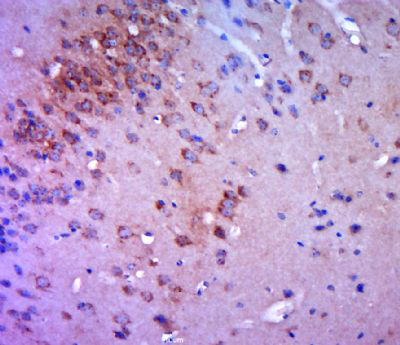产品货号 : mlR15424
英文名称 : HCCS
中文名称 : 全细胞色素C合成酶抗体
别 名 : CCHL; DKFZp779I1858; EC 4.4.1.17; Holocytochrome c synthase (cytochrome c heme lyase); Holocytochrome c type synthase; MCOPS7; OTTHUMP00000022903; OTTHUMP00000022904; OTTHUMP00000022905; OTTMUSP00000021173; OTTMUSP00000021174; RGD1563855; RP23-37L2.1; CCHL_HUMAN.
研究领域 : 心血管 信号转导 新陈代谢
抗体来源 : Rabbit
克隆类型 : Polyclonal
交叉反应 : Human, Mouse, Rat, Dog, Horse,
产品应用 : ELISA=1:500-1000 IHC-P=1:400-800 IHC-F=1:400-800 ICC=1:100-500 IF=1:100-500 (石蜡切片需做抗原修复)
not yet tested in other applications.
optimal dilutions/concentrations should be determined by the end user.
分 子 量 : 31kDa
细胞定位 : 细胞浆
性 状 : Lyophilized or Liquid
浓 度 : 1mg/ml
免 疫 原 : KLH conjugated synthetic peptide derived from human HCCS:51-150/268
亚 型 : IgG
纯化方法 : affinity purified by Protein A
储 存 液 : 0.01M TBS(pH7.4) with 1% BSA, 0.03% Proclin300 and 50% Glycerol.
保存条件 : Store at -20 °C for one year. Avoid repeated freeze/thaw cycles. The lyophilized antibody is stable at room temperature for at least one month and for greater than a year when kept at -20°C. When reconstituted in sterile pH 7.4 0.01M PBS or diluent of antibody the antibody is stable for at least two weeks at 2-4 °C.
PubMed : PubMed
产品介绍 : HCCS is a 79 amino acid protein that may act as a tumor suppressor, promoting the apoptosis of cancer cells. Expressed in leukocytes, lung, spleen, liver, heart, kidney, muscle and uterine cervix, HCCS-1 is down-regulated in cervical cancers. The gene encoding HCCS-1 maps to human chromosome 15q25.1. Encoding more than 700 genes, chromosome 15 is made up of approximately 106 million base pairs and comprises about 3% of the human genome. Angelman and Prader-Willi syndromes are associated with loss of function or deletion of genes in the 15q11-q13 region. Tay-Sachs disease is a lethal disorder associated with mutations of the HEXA gene, which is encoded by chromosome 15. Marfan syndrome is associated with chromosome 15 through the FBN1 gene.
Function:
Links covalently the heme group to the apoprotein of cytochrome c (By similarity).
Subcellular Location:
Mitochondrion inner membrane (Potential).
DISEASE:
Microphthalmia, syndromic, 7 (MCOPS7) [MIM:309801]: A disease characterized by unilateral or bilateral microphthalmia, linear skin defects in affected females, and in utero lethality for males. Skin defects are limited to the face and neck, consisting of areas of aplastic skin that heal with age to form hyperpigmented areas. Additional features in female patients include agenesis of the corpus callosum, sclerocornea, chorioretinal abnormalities, infantile seizures, congenital heart defect, mental retardation, and diaphragmatic hernia. Microphthalmia is a disorder of eye formation, ranging from small size of a single eye to complete bilateral absence of ocular tissues (anophthalmia). In many cases, microphthalmia/anophthalmia occurs in association with syndromes that include non-ocular abnormalities. Note=The disease is caused by mutations affecting the gene represented in this entry.
Similarity:
Belongs to the cytochrome c-type heme lyase family.
Contains 2 HRM (heme regulatory motif) repeats.
SWISS:
P53701
Gene ID:
3052
Important Note:
This product as supplied is intended for research use only, not for use in human, therapeutic or diagnostic applications.
产品图片












